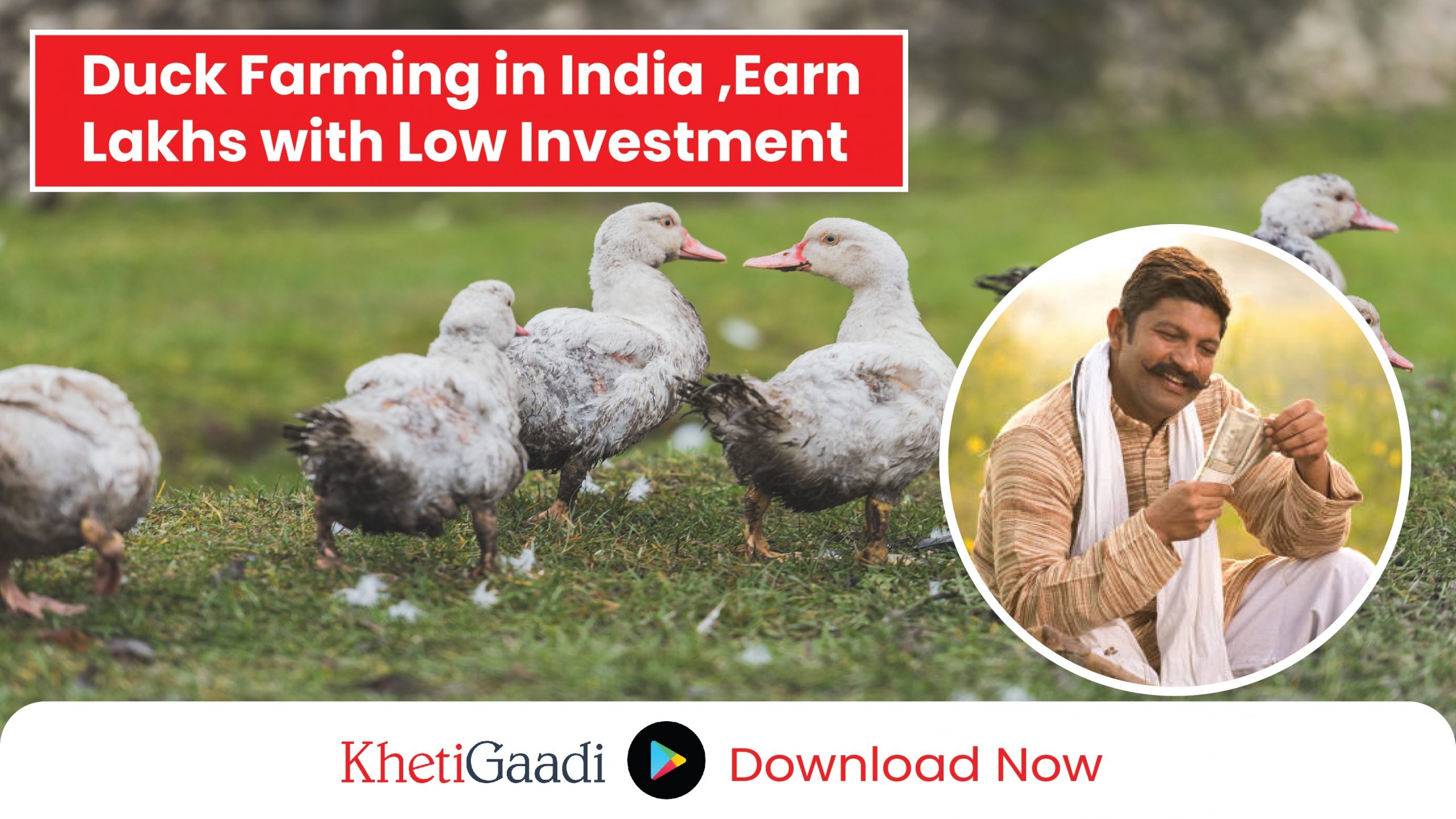Duck farming in India is emerging as a lucrative business opportunity, offering a steady income stream for both small-scale and large-scale farmers. With a relatively low investment, this venture has the potential to yield profits in lakhs, thanks to the high demand for duck eggs, meat, and feathers. This blog will guide you through the essentials of duck farming, benefits, financial assistance, and a detailed investment-profit analysis, ensuring you have all the information you need to start your successful duck farming business.
Duck Farming Guidelines for Beginners
Starting a duck farm requires careful planning and a good understanding of the various aspects involved in raising ducks. Here’s a step-by-step guide to help you get started:
- Choosing the Right Breed:
- Selecting the right duck breed is crucial for success. Commonly raised breeds in India include Khaki Campbell (known for high egg production), Indian Runner, and Pekin (famous for meat). Research the breeds that align with your business goals, whether it’s egg production, meat, or both.
- Farm Location and Housing:
- Ducks are hardy birds and adapt well to different environments, but selecting a location with access to water bodies like ponds or rivers can be advantageous. Ensure the farm has adequate shelter to protect ducks from predators and harsh weather. Proper ventilation and a clean, dry environment are essential to prevent diseases.
- Feeding and Nutrition:
- Ducks require a balanced diet to ensure optimal growth and productivity. Their diet should include grains, greens, and commercial duck feed rich in protein. Additionally, ducks benefit from free-ranging, where they can forage for insects and aquatic plants, reducing feed costs.
- Health Management:
- Regular health check-ups and vaccinations are crucial to prevent diseases like Duck Plague, Duck Cholera, and Avian Influenza. Maintain cleanliness in the housing area and ensure a constant supply of clean water.
- Breeding and Egg Incubation:
- Ducks generally start laying eggs at 6-7 months of age. For breeding, ensure a proper male-to-female ratio (usually 1:5). Incubation can be done naturally or using incubators, with a hatching period of around 28 days.
Benefits of Duck Farming
Duck farming offers several advantages that make it a profitable venture:
- High Demand and Market Value:
- Duck eggs and meat have a steady demand in the Indian market, especially in states like West Bengal, Kerala, and Tamil Nadu. Duck eggs are considered more nutritious than chicken eggs and are sold at a premium price.
- Low Maintenance and Feeding Costs:
- Ducks are easier to manage compared to chickens and can thrive on a variety of food sources, including kitchen scraps and natural forage. This reduces the overall feeding cost.
- Resilience to Diseases:
- Ducks are less prone to many common poultry diseases, making them a more resilient and less risky farming option.
- Multi-functional By-products:
- Apart from eggs and meat, ducks provide feathers and down, which are used in the textile industry, adding another revenue stream.
- Environmental Benefits:
- Ducks can be integrated with rice farming, where they help control pests and weeds while fertilizing the fields with their droppings, promoting sustainable farming practices.
Duck Farming Loans and Subsidy
To encourage duck farming, the Indian government offers various financial schemes and subsidies:
- NABARD Subsidy for Duck Farming:
- The National Bank for Agriculture and Rural Development (NABARD) provides subsidies under the Poultry Venture Capital Fund (PVCF) scheme. Farmers can avail subsidies of up to 25-33% of the total project cost.
- Agricultural Loans:
- Banks and financial institutions offer loans specifically for poultry and duck farming. These loans cover expenses like purchasing ducks, feed, construction of sheds, and equipment. Interest rates on these loans are relatively low, and repayment periods are flexible.
- State Government Schemes:
- Several state governments also provide additional incentives, subsidies, and training programs for duck farmers. For example, Kerala and West Bengal have specific schemes promoting duck farming in rural areas.
Duck Farming Investment and Profit Earning
To provide a clear picture of the potential earnings from duck farming, let’s break down the investment and profit scenario:
- Initial Investment:
- Land and Housing: ₹50,000 – ₹1,00,000 (depending on the scale)
- Ducklings: ₹30,000 – ₹50,000 for 200-300 ducklings
- Feed and Nutrition: ₹40,000 – ₹60,000 per year
- Miscellaneous (health, equipment, etc.): ₹20,000 – ₹30,000
- Total Initial Investment: ₹1,40,000 – ₹2,40,000
- Annual Expenses:
- Feed and Water: ₹40,000 – ₹60,000
- Healthcare and Maintenance: ₹10,000 – ₹20,000
- Labour Costs: ₹30,000 – ₹50,000
- Miscellaneous: ₹5,000 – ₹10,000
- Total Annual Expenses: ₹85,000 – ₹1,40,000
- Profit Calculation:
- Egg Production: On average, a duck lays 250-300 eggs per year. Selling price per egg is around ₹5-7. For 300 ducks, this results in:
- Total Eggs: 75,000 – 90,000 eggs/year
- Revenue from Eggs: ₹3,75,000 – ₹6,30,000
- Meat Production: Selling price for duck meat ranges from ₹250-₹350/kg. Assuming 200 ducks are sold for meat annually:
- Revenue from Meat: ₹5,00,000 – ₹7,00,000
- Total Revenue: ₹8,75,000 – ₹13,30,000
- Net Profit:
- Net Profit: ₹7,35,000 – ₹11,90,000 annually
With proper management and optimization of resources, it is feasible to earn in lakhs from duck farming within a year or two of operation.
Case Study 1
Ramesh Kumar’s Duck Farming Success in West Bengal
Background: Ramesh Kumar, a resident of a small village in West Bengal, began his journey into duck farming in 2018. Initially, he was a small-scale farmer with a background in rice cultivation, but he sought to diversify his income sources.
The Venture: Ramesh started with 300 Khaki Campbell ducks, investing approximately ₹1,50,000 in purchasing the ducks, building a shed, and buying initial feed. He utilized his farm’s existing water bodies, which provided an ideal environment for ducks.
Challenges Faced: In the initial months, Ramesh faced challenges with duck health and feed management. He sought assistance from local agricultural extension services and availed a subsidy under the Poultry Venture Capital Fund (PVCF) from NABARD, which covered 30% of his expenses.
Success: With consistent care and improved feeding practices, Ramesh’s duck farm began to thrive. By the end of the first year, he was producing 75,000 eggs and selling them at an average price of ₹6 per egg, generating a revenue of ₹4,50,000. Additionally, he sold 150 ducks for meat, earning an additional ₹5,00,000.
Financial Overview:
- Total Revenue: ₹9,50,000
- Total Expenses: ₹3,00,000 (including initial investment and annual expenses)
- Net Profit: ₹6,50,000
Outcome: Ramesh’s success in duck farming allowed him to expand his business. He reinvested his profits into increasing the number of ducks and improving infrastructure. Today, his farm supports a livelihood for several families in his village and has become a model for local farmers.
Case Study 2
Anjali Patel’s Duck Farming Triumph in Gujarat
Background: Anjali Patel, a progressive farmer in Gujarat, turned to duck farming in 2020 after attending a series of agricultural workshops. She was particularly interested in the profitability of duck meat and eggs and aimed to start a medium-scale operation.
The Venture: Anjali invested ₹2,00,000 to set up her duck farm, purchasing 500 Pekin ducks, constructing a well-equipped shed, and installing an efficient water system. She also received a loan from a local bank tailored for poultry farming, which provided her with the necessary capital.
Challenges Faced: Anjali initially struggled with optimizing feed and managing duck health. She attended training sessions on best practices and utilized online resources to improve her farming techniques. She also benefited from a state government subsidy that supported her with additional funds for healthcare and feed.
Success: By the end of the second year, Anjali’s farm was producing 1,50,000 eggs and 300 ducks for meat. The average selling price for eggs was ₹7 each, and for meat, it was ₹300 per kg. Her total revenue from eggs and meat reached approximately ₹10,00,000.
Financial Overview:
- Total Revenue: ₹10,00,000
- Total Expenses: ₹4,00,000 (including loan repayments and operational costs)
- Net Profit: ₹6,00,000
Outcome: Anjali’s success story spread across her region, leading to several local farmers seeking her advice. She expanded her farm to include more ducks and began selling value-added products like duck sausages. Her innovative approach and successful management have established her as a prominent figure in the duck farming community.
These success stories highlight the potential of duck farming to provide substantial income and improve livelihoods. They also emphasize the importance of proper planning, utilization of available resources, and ongoing learning in achieving success in this field.
Conclusion
Duck farming is an excellent business opportunity for those looking to invest in a low-risk, high-reward venture. By following the guidelines provided, taking advantage of government subsidies and loans, and managing your farm efficiently, you can turn duck farming into a profitable enterprise, earning in lakhs annually. Whether you are a beginner or an experienced farmer, the potential for growth in this sector is immense. Invest in duck farming today and embark on a journey towards financial independence and agricultural success.
Important links:
NABARD Subsidy for Duck Farming
Poultry Venture Capital Fund Scheme
Tags




